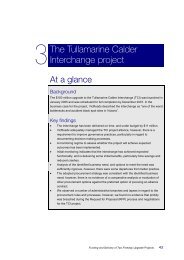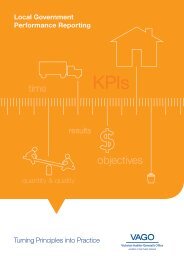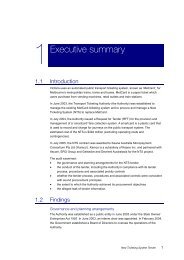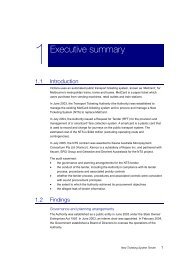Delivering HealthSmart Report - VAGO
Delivering HealthSmart Report - VAGO
Delivering HealthSmart Report - VAGO
Create successful ePaper yourself
Turn your PDF publications into a flip-book with our unique Google optimized e-Paper software.
Monitoring and review of the program<br />
At the time of the audit, neither OHIS nor the health agencies we audited have any<br />
way of ascertaining if they were effectively communicating with their key stakeholders<br />
Agency participation<br />
Some agencies have been enthusiastic supporters of the program and have made a<br />
strategic decision to align with the strategy. Other agencies have been more reluctant<br />
and difficult to convince.<br />
Obtaining agency participation and getting participating agencies to agree to the<br />
implementation has been a challenge for the program. Agencies explained these<br />
delays in terms of their view that:<br />
• OHIS had not provided them with reliable information on system implementation<br />
and/or ongoing costs which would be sufficient for their boards to approve<br />
• there were cheaper solutions in the market<br />
• there could be a loss of functionality after implementation of HealthSMART<br />
applications.<br />
As discussed in part 2 of this report, poor early buy-in by agencies has lead to an<br />
enforced participation policy, which was developed in February 2006 and promulgated<br />
by the Secretary of DHS to health agencies. This policy requires agencies which intend<br />
to introduce or replace ICT systems to implement the relevant HealthSMART system.<br />
An agency will be granted an exemption from this policy if it is part of a larger national<br />
organisation and is required to use its system, or if the agency’s needs differ<br />
significantly from the HealthSMART system. The Secretary of DHS must approve any<br />
exemptions. Exempt agencies will be required to pay the full cost of implementing an<br />
application and integrating it with the HealthSMART systems. Agencies will not be<br />
granted an exemption merely because their preferred solution has the same or<br />
reduced functionality, or is cheaper than the equivalent HealthSMART system.<br />
To date the sole application for exemption has been approved. The Loddon Mallee<br />
Health ICT Alliance was granted an exemption to upgrade a non-HealthSMART PCMS.<br />
This exemption was granted as the PCMS at Bendigo Health and Echuca Health was<br />
obsolete and OHIS was not able to accommodate an additional implementation at that<br />
point in time.<br />
Conclusion<br />
The HealthSMART PMO has attempted to manage stakeholders effectively in a difficult<br />
environment. However, due to various pressures faced by health agencies, some<br />
stakeholders have been resistant to the implementation approach used by OHIS.<br />
OHIS could assist agencies to improve communication with staff and assist agencies<br />
to better inform staff about the progress and expected benefits of the program after<br />
implementation.<br />
<strong>Delivering</strong> HealthSMART — Victoria's whole-of-health ICT strategy 55
















